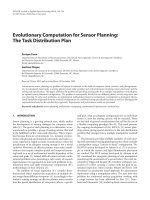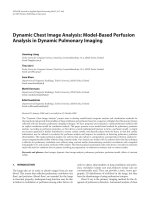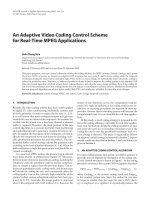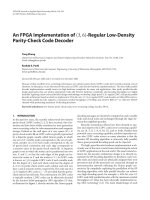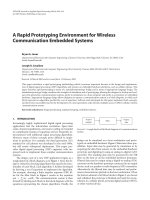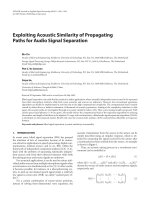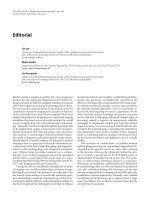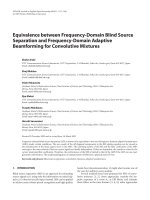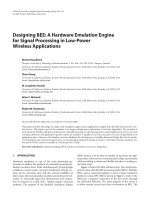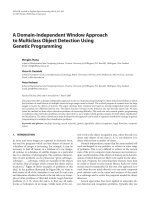EURASIP Journal on Applied Signal Processing 2003:10, 980–992 c 2003 Hindawi Publishing potx
Bạn đang xem bản rút gọn của tài liệu. Xem và tải ngay bản đầy đủ của tài liệu tại đây (773.83 KB, 13 trang )
EURASIP Journal on Applied Signal Processing 2003:10, 980–992
c
2003 Hindawi Publishing Corporation
Progressive Syntax-Rich Coding of Multichannel
Audio Sources
Dai Yang
Integrated Media Systems Center and Department of Electrical Engineering, University of Southern California,
Los Angeles, CA 90089-2564, USA
Email:
Hongmei Ai
Integrated Media Systems Center and Department of Electrical Engineering, University of Southern California,
Los Angeles, CA 90089-2564, USA
Email:
Chris Kyriakakis
Integrated Media Systems Center and Department of Electrical Engineering, University of Southern California,
Los Angeles, CA 90089-2564, USA
Email:
C C. Jay Kuo
Integrated Media Systems Center and Department of Electrical Engineering, University of Southern California,
Los Angeles, CA 90089-2564, USA
Email:
Received 6 May 2002 and in revised form 5 March 2003
Being able to transmit the audio bitstream progressively is a highly desirable property for network transmission. MPEG-4 version 2
audio supports fine grain bit rate scalability in the generic audio coder (GAC). It has a bit-sliced arithmetic coding (BSAC) tool,
which provides scalability in the step of 1 Kbps per audio channel. There are also several other scalable audio coding methods,
which have been proposed in recent years. However, these scalable audio tools are only available for mono and stereo audio
material. Little work has been done on progressive coding of multichannel audio sources. MPEG advanced audio coding (AAC)
is one of the most distinguished multichannel digital audio compression systems. Based on AAC, we develop in this work a
progressive syntax-rich multichannel audio codec (PSMAC). It not only supports fine grain bit rate scalability for the multichannel
audio bitstream but also provides several other desirable functionalities. A formal subjective listening test shows that the proposed
algorithm achieves an excellent performance at several different bit rates when compared with MPEG AAC.
Keywords and phrases: multichannel audio, progressive coding, Karhunen-Lo
´
eve transform, successive quantization, PSMAC.
1. INTRODUCTION
Multichannel audio technologies have become much more
mature these days, partially pushed by the need of the film
industry and home entertainment systems. Starting from the
monophonic technology, new systems, such as stereophonic,
quadraphonic, 5.1 channels, and 10.2 channels, are penetrat-
ing into the market very quickly. Compared with the mono
or stereo sound, multichannel audio provides end users a
more compelling experience and becomes more appealing
to music producers. As a result, an efficient coding scheme
for multichannel audio storage and transmission is in great
demand. Among several existing multichannel audio com-
pression algorithms, Dolby AC-3 and MPEG advanced au-
dio coding (AAC) [1, 2, 3, 4] are two most prevalent percep-
tual digital audio coding systems. Both of them can provide
perceptually indistinguishable audio quality at the bit rate of
64 Kbps/ch.
In spite of their success, they can only provide bitstreams
with a fixed bit rate, which is specified during the encod-
ing phase. When this kind of bitstream is transmitted over
variable bandwidth networks, the receiver can either success-
fully decode the full bitstream or ask the encoder to retrans-
mit a bitst ream with a lower bit rate. The best solution to
this problem is to develop a scalable compression algorithm
to transmit and decode the audio content in an embedded
Progressive Syntax-Rich Coding of Multichannel Audio Sources 981
manner. To be more specific, a bitstream generated by a
scalable coding scheme consists of several par tial bitstreams,
each of which can be decoded on their own in a meaning-
ful way. Therefore, transmission and decoding of a subset of
the total bitstream will result in a valid decodable signal at a
lower bit rate and quality. This capability offers a sig nificant
advantage in transmitting contents over networks with vari-
able channel capacity and heterogeneous access bandwidth.
MPEG-4 version 2 audio coding supports fine grain bit
rate scalablility [5, 6, 7, 8, 9] in its generic audio coder (GAC).
It has a bit-sliced arithmetic coding (BSAC) tool, which pro-
vides scalability in the step of 1 Kbps per audio channel for
mono or stereo audio material. Several other scalable mono
or stereo audio coding algorithms [10, 11, 12] were proposed
in recent years. However, not much work has been done on
progressive coding of multichannel audio sources. In this
work, we propose a progressive syntax-rich multichannel au-
dio codec (PSMAC) based on MPEG AAC. In PSMAC, the
interchannel redundancy inherent in original physical chan-
nels is first removed in the preprocessing stage by using the
Karhunen-Lo
´
eve transform (KLT). Then, most coding blocks
in the AAC main profile encoder are employed to generate
spectral coefficients. Finally, a progressive transmission st rat-
egy and a context-based QM-coder are adopted to obtain the
fully quality-scalable multichannel audio bitstream. The PS-
MAC system not only supports fine-grain bit rate scalabil-
ity for the multichannel audio bitstream, but also provides
several other desirable functionalities, such as random access
and channel enhancement, which have not been supported
by other existing multichannel audio codecs (MAC).
Moreover, compared with the BSAC tool provided in
MPEG-4 version 2 and most of the other scalable audio
coding tools, a more sophisticated progressive transmission
strategy is employed in PSMAC. PSMAC does not only en-
code spectral coefficients from MSB to LSB and from low to
high frequency so that the decoder can reconstruct these co-
efficients more and m ore precisely with an increasing band-
width as the receiver collects more and more bits from the
bitstream, but also utilizes the psychoacoustic model to con-
trol the subband transmission sequence so that the most sen-
sitive frequency area is more precisely reconstructed. In this
way, bits used to encode coefficients in those nonsensitive fre-
quency area can be saved and used to encode coefficients in
the sensitive frequency area. As a result of this subband se-
lection strategy, a perceptually more appealing audio can be
reconstructed by PSMAC, especially at very low bit rates such
as 16 Kbps/ch. The side information required to encode the
subband transmission sequence is carefully handled in our
implementation so that the overall overhead will not have
significant impact on the audio quality even at very low bit
rates. Note that Shen et al. [12] proposed a subband selection
rule to achieve progressive coding. However, Shen’s scheme
demands a large amount of overhead in coding the selection
order.
Experimental results show that, when compared with
MPEG AAC, the decoded multichannel audio generated by
the proposed PSMAC’s mask-to-noise-ratio (MNR) progres-
sive mode has comparable quality at high bit rates, such as
64 Kbps/ch or 48 Kbps/ch, and much better quality at low bit
rates, such as 32 Kbps/ch or 16 Kbps/ch. We also demonstrate
that our PSMAC can provide better quality of single-channel
audio when compared with MPEG-4 version 2 GAC at sev-
eral different bit rates.
The rest of the paper is organized as follows. Section 2
gives an overview of the proposed design. Section 3 briefly
introduces how interchannel redundancy can be removed
via the KLT. Sections 4 and 5 describe progressive quantiza-
tion and subband selection blocks in our system, respectively.
Section 6 presents the complete compression system. Experi-
mental results are shown in Section 7. Finally, conclusion re-
marks are given in Section 8 .
2. PROFILES OF PROPOSED PROGRESSIVE
SYNTAX-RICH AUDIO CODEC
In the proposed progressive syntax-rich codec, the following
three user-defined profiles are provided.
(1) The MNR progressive profile. If the flag of this profile
is on, it should be possible to decode the first n bytes
of the bitstream per second, where n is a user-specified
value or a value that the current network par ameters
allowed.
(2) The random access profile. If the flag of this profile is
present, the codec will be able to independently encode
a short period of audio more precisely than other pe-
riods. It allows users to randomly access a certain part
of audio that is more of interest to end users.
(3) The channel enhancement profile. If the flag of this
profile is on, the codec will be able to independently
encode an audio channel more precisely than other
channels. Either these channels are of more interest
to end users or the network situation does not allow
the full multichannel audio bitstream to be received on
time.
Figure 1 illustrates a simple example of three user-
defined profiles. Among all profiles, the MNR progressive
profile is the default one. In the other two profiles, that is,
the random access and the channel enhancement, the MNR
progressive feature is still provided as a basic functionality
and the decoding of the bitstream can be stopped at any ar-
bitrary point. With these three profiles, the proposed codec
can provide a versatile set of functionalities desir a ble in vari-
able bandwidth network conditions with different user access
bandwidth.
3. INTERCHANNEL DECORRELATION
For a given time instance, removing interchannel redun-
dancy would result in a significant bandwidth reduction.
This can be done via an orthogonal transform MV
= U,
where V and U denote the vector whose n elements are sam-
ples in original channels and transformed channels, respec-
tively. Among several commonly used transforms, including
the discrete cosine transform (DCT), the Fourier transform
982 EURASIP Journal on Applied Signal Processing
Bitstream
(Low quality)
Bitstream
+
Bitstream
(Median quality)
Bitstream
+
Bitstream
+
Bitstream
(High quality)
(a)
Lower quality Higher quality Lower quality
(b)
Lower quality Higher quality Lower quality
Lower quality
Surround
Left Center Right
Lower quality
Surround
(c)
Figure 1: Illustration of three user-defined profiles: (a) the MNR progressive profile, (b) the random access profile, and (c) the channel
enhancement with the enhanced center channel.
(FT), and the KLT, the signal-dependent KLT is adopted in
the preprocessing stage because it is theoretically optimal in
decorrelating signals across channels. If M is the KLT ma-
trix, we call the corresponding transformed channels eigen-
channels. Figure 2 illustrates how KLT is perform ed on mul-
tichannel audio signals, where the columns of the KLT matrix
are composed of eigenvectors calculated from the covariance
matrix C
V
associated w ith original multichannel audio sig-
nals V.
Suppose that an input audio signal has n channels, then
the covariance of KL transformed signals is
E
¯
U
¯
U
T
= E
(M
¯
V)(M
¯
V)
T
= ME
¯
V
¯
V
T
M
T
= MC
V
M
T
=
λ
1
0 ··· 0
0 λ
2
··· 0
.
.
.
.
.
.
.
.
.
.
.
.
00··· λ
n
,
(1)
where
¯
X (X = U, V) represents the mean-removed signal of
X,andλ
1
,λ
2
, ,λ
n
are eigenvalues of C
V
. Thus, the trans-
form produces statistically decorrelated channels in the sense
of having a diagonal covariance matrix for transformed sig-
nals. Another property of KLT, which can be used in the re-
construction of audio of original channels, is that the inverse
transform matrix of M is equal to its transpose. Since C
V
is
real and symmetric, the matrix formed by normalized eigen-
vectors is orthonormal. Therefore, we have V = M
T
U in re-
construction. From KL expansion theory [13], we know that
selecting eigenvectors associated with the largest eigenvalues
can minimize the error between original a nd reconstructed
channels. This error will go to zero if all eigenvectors are u sed.
KLT is thus optimum in the least square error sense.
The KLT preprocessing method was demonstrated to im-
prove the multichannel audio coding efficiency in our previ-
ous work [14, 15, 16]. After the preprocessing stage, signals
in these relatively independent channels called eigenchannels
are further processed.
Progressive Syntax-Rich Coding of Multichannel Audio Sources 983
Original multichannel audio
signals with high correlation
between channels
Eigenchannel audio signals
with little correlation
between channels
KL transform
matrix
M
Correlated
component
V
Decorrelated
component
U
×=
Figure 2: Interchannel decorrelation via KLT.
4. SCALABLE QUANTIZATION AND ENTROPY CODING
The major difference between the proposed progressive au-
dio codec and other existing nonprogressive audio codecs
such as AAC lies in the quantization block and the entropy
coding block. The dual iteration loop used in AAC to cal-
culate the quantization step size for each frame and each
channel coefficients is replaced by a progressive quantiza-
tion block. The Huffman coding block used in the AAC to
encode quantized data is replaced by a context-based QM-
coder. This will be explained in detail below.
4.1. Successive approximation quantization (SAQ)
The most important component of the quantization block
is called successive approximation quantization (SAQ). The
SAQ scheme, which is adopted by most embedded wavelet
coders for progressive image coding, is crucial to the design
of embedded coders. The motivation for successive approx-
imation is built upon the goal of developing an embedded
code that is in analogy to find an approximation of binary
representation of a real number [17]. Instead of coding every
quantized coefficient as one symbol, SAQ processes the bit
representation of coefficients via bit layers sliced in the or-
der of their importance. Thus, SAQ provides a coarse-to-fine,
multiprecision representation of the amplitude information.
The bitstream is organized such that a decoder can immedi-
ately star t reconstruction based on the partially received bit-
stream. A s more and more bits are received, more accurate
coefficients and higher quality multichannel audio can b e re-
constructed.
SAQ sequentially applies a sequence of thresholds T
0
,
T
1
, ,T
N+1
for refined quantization, where these thresholds
are chosen such that T
i
= T
i−1
/2. The initial threshold T
0
is selected such that |C(i)| < 2T
0
for all transformed coeffi-
cients in one subband, where C(i) represents the ith spectral
coefficient in the subband. To implement SAQ, two separate
lists, the dominant list and the subordinate list, are main-
tained both at the encoder and the decoder. At any point
of the process, the dominant list contains the coordinates
of those coefficients that have not yet been found to be sig-
nificant, while the subordinate list contains magnitudes of
those coefficients that have been found to be significant. The
process that updates the dominate list is called the signifi-
cant pass, and the process that updates the subordinate list is
called the refinement pass.
In the proposed algorithm, SAQ is adopted as the quanti-
zation method for each spectral coefficient within each sub-
band. This algorithm (for the encoder part) is listed below.
Successive approximation quantization (SAQ) algorithm
(1) Initialization: For each subband, find out the maxi-
mum absolute value C
max
for all coefficients C(i) in the
subband, and set the initial quantization threshold to
be T
0
= C
max
/2+∆,where∆ is a small constant.
(2) Construction of the significant map (significance iden-
tification). For each C(i) contained in the dominant
list, if |C( i)|≥T
k
,whereT
k
is the threshold of the
current layer (layer k), add i to the significant map, re-
move i from the dominant list, and encode it with “1s,”
where “s” is the sign bit. Moreover, modify the coeffi-
cient’s value to
C(i) ←−
C(i) − 1.5T
k
, ∀C(i) > 0,
C(i)+1.5T
k
, otherwise.
(2)
(3) Construction of the refinement map (refinement). For
each C(i) contained in the significant map, encode the
bitatlayerk with a refinement bit “D” and change the
value of C(i)to
C(i) ←−
C(i) − 0.25T
k
, ∀C(i) > 0,
C(i)+0.25T
k
, otherwise.
(3)
(4) Iteration. Set T
k+1
= T
k
/2 and repeat steps (2)–(4) for
k = 0, 1, 2,
At the decoder side, the decoder performs similar steps
to reconstruct coefficients’ values. Figure 3 gives a simple ex-
ample to show how the decoder reconstructs a single coeffi-
cient after one significant pass and one refinement pass. As
illustrated in this figure, the magnitude of this coefficient is
recovered t o 1.5 times of the current threshold T
k
after the
significant pass, and then refined to 1.5T
k
− 0.25T
k
after the
first refinement pass. As more refinement steps follow, the
magnitudeofthiscoefficient will approach its original value
gradually.
4.2. Context-based QM-coder
The QM-coder is a binary arithmetic coding algorithm de-
signed to encode data formed by a binary symbol set. It
was the result of the effort by JPEG and JBIG commit-
tees, in which the best features of various arithmetic coders
are integrated. The QM-coder is a lineal descendent of the
Q-coder, but significantly enhanced by improvements in
the two building blocks, that is, interval subdivision and
984 EURASIP Journal on Applied Signal Processing
Significant pass
1.5T
k
Refinement pass
1.5T
k
− 0.25T
k
T
k
Threshold
Original
value
Reconstruct
value
Reconstruct
value
Figure 3: An example to show how the decoder reconstructs a sin-
gle coefficient after one significant pass and one refinement pass.
probability estimation [18]. Based on the Bayesian estima-
tion, a state-transition table, which consists of a set of rules
to estimate the statistics of the bitstream depending on the
next incoming symbols, can be derived. The efficiency of the
QM-coder can be improved by introducing a set of context
rules. The QM arithmetic coder achieves a very good com-
pression result if the context is properly selected to summa-
rize the correlation between coded data.
Six classes of contexts are used in the proposed embed-
ded audio codec as shown in Figure 4. They are the general
context, the constant context, the subband significance con-
text, the coefficient significance context, the coefficient re-
finement context, and the coefficient sign context. The gen-
eral context is used in the coding of the configuration in-
formation. The constant context is used to encode different
channel header information. As their names suggest, the sub-
band significance context, the coefficient sig nificance con-
text, the coefficient refinement context, and the coefficient
sign context a re used to encode the subband significance, co-
efficient significance, coefficient refinement, and coefficient
sign bits, respectively. These contexts are adopted because
different classes of bits may have different probability dis-
tributions. In principle, separating their contexts should in-
crease the coding performance of the QM-coder.
5. CHANNEL AND SUBBAND TRANSMISSION
STRATEGY
5.1. Channel selection rule
In the embedded MAC, we should put the most important
bits (in the rate-distortion sense) to the cascaded bitstream
first so that the decoder can reconstruct the optimal quality
of multichannel audio given a fixed number of bits received.
Thus, the importance of channels should be determined for
an appropriate order of the bitstream.
The first instinct about the metric of channel importance
would be the energy of the audio signal in each channel.
However, this metric does not work well in general. For ex-
ample, for some multichannel audio sources, especially for
those that have been reproduced artificially in a music stu-
dio, the side channel which does not normally contain the
main melody may even have a larger energy than the center
channel. Based on our experience with multichannel audio,
loss or significant distor tion of the main melody in the center
channel would be much more annoying than loss of melodies
in side channels. In other words, the location of channels also
plays an important role. Therefore, for a regular 5.1chan-
nel configuration, the order of channel importance from the
largest to the least should be
(1) center channel,
(2) left and right (L/R) channel pair,
(3) left surround and right surround (Ls/Rs) channel pair,
(4) low-frequency channel.
Between channel pairs, their importance can be determined
by their energy values. This rule is adopted in our experi-
ments, given in Section 7.
After KLT, eigenchannels are no longer the original phys-
ical channels, and sounds in different physical channels are
mixed in every eigenchannel. Thus, spatial dependency of
eigenchannels is less trivial. We observe from experiments
that a lthough it is true that one eigenchannel may contain
sounds from more than one original physical channel, there
still exists a close correspondence between eigenchannels and
physical channels. To be more precise, audio of eigenchannel
1 would sound similar to that of the center channel, audio
of eigenchannels 2 and 3 would sound similar to that of the
L/R channel pair, and so forth. Therefore, if eigenchannel 1 is
lost in transmission, we would end up with a very distorted
center channel. Moreover, it happens that, sometimes, eigen-
channel 1 may not the channel with a very large energy and
could be easily discarded if the channel energy is adopted as
the metric of channel importance. Thus, the channel impor-
tance of eigenchannels should be similar to that of physical
channels, that is, eigenchannel 1 corresponding to the cen-
ter channel, eigenchannels 2 and 3 corresponding to the L/R
channel pair, and eigenchannels 4 and 5 corresponding to the
Ls/Rs channel pair. Within each channel pair, the importance
is still determined by their energy values.
5.2. Subband selection rule
In principle, any quality assessment of an audio channel can
be either performed subjectively by employing a large num-
ber of expert listeners or done objectively by using an ap-
propriate measuring technique. While the first choice tends
to be an expensive and time-consuming task, the use of
objective measures provides quick and reproducible results.
An optimal measuring technique would be a method that
produces the same results as subjective tests while avoiding
all problems associated with the subjective assessment pro-
cedure. Nowadays, the most prevalent objective measure-
ment is the MNR technique, which was first introduced by
Progressive Syntax-Rich Coding of Multichannel Audio Sources 985
Quantizer
Program configuration
bitstream
Channel header info
bitstream
Subband significance
bitstream
Coefficient significance
bitstream
Coefficient refinement
bitstream
Coefficient sign
bitstream
Compressed file
Figure 4: The adopted context-based QM-coder with six classes of contexts.
Brandenburg [19] in 1987. It is the ratio of the masking
threshold with respect to the error energy. In our imple-
mentation, the masking is calculated from the general psy-
choacoustic model of the AAC encoder. The psychoacous-
tic model calculates the maximum distortion energy which is
masked by the signal energy, and outputs the signal to mask
ratio (SMR).
A subband is masked if the quantization noise level is be-
low the masking threshold, so the distortion introduced by
the quantization process is not perceptible to human ears.
As discussed earlier, SMR represents the human auditory re-
sponse to the audio signal. If SNR of an input audio signal is
high enough, the noise level will be suppressed below mask-
ing threshold, and the quantization distortion will not be
perceived. Since SNR can be easily calculated by
SNR =
i
S
original
(i)
2
i
S
original
(i) − S
reconstruct
(i)
2
, (4)
where S
original
(i)andS
reconstruct
(i) represent the ith original
and the ith reconstructed audio signal value, respectively,
thus, MNR is just the difference between SNR and SMR (in
dB) or
SNR = MNR + SMR . (5)
A side benefit of the SAQ technique is that an operational
rate versus distortion plot (or, equivalently, an operational
rate versus the current MNR value) for the coding algorithm
can be computed online.
100
90
80
70
60
50
40
30
20
10
0
Width
0 5 10 15 20 25 30 35 40 45 50
Subband
Figure 5: Subband width distribution.
The basic ideas behind choosing the subband selection
rules are simple. They are presented as follows:
(1) the subband with a better rate deduction capability
should be chosen earlier to enhance the performance;
(2) the subband with a smaller number of coefficients
should b e chosen earlier to reduce the computational
complexity if the rate reduction performances of two
subbands are close.
Thefirstruleimpliesthatweshouldallocatemorebits
to those subbands with larger SMR values (or smaller MNR
986 EURASIP Journal on Applied Signal Processing
SB #1 SB #2
SB #L
B
SB #L
E1
SB #L
E2
SB #L
E3
Subband scanning for base layer
Subband scanning for first enhance layer
Subband scanning for second enhance layer
Subband scanning for third enhance layer
Figure 6: Illustration of the subband scanning rule, w here the solid line with an arrow means that all subbands inside this area are scanned,
and t he dashed line means that only those nonsignificant subbands inside the area are scanned.
values). In other words, we should send out bits belonging to
those subbands with larger SMR values (or smaller MNR val-
ues) first. The second rule tells us how to decide the subband
scanning order. As we know about the subband
1
formation
in MPEG AAC, the number of coefficients in each subband
is nondecreasing with the increase of the subband number.
Figure 5 shows the subband width distribution used in AAC
for 44.1 kHz and 48 kHz sampling frequencies and long block
frames. Thus, a s equential subband scanning order from the
lowest number to the highest number is adopted in this
work.
In order to save bits, especially at very low bit rates, only
information corresponding to lower subbands will be sent
into the bitstream at the first layer. When the number of
layers increases, more and more subbands will be added.
Figure 6 shows how subbands are scanned for the first sev-
eral layers. At the base layer, the priority is given to lower-
frequency signals so that only subbands numbered up to L
B
will be scanned. As the information of enhancement layers is
added to the bitstream, the subband scanning upper limit in-
creases (as indicated by values of L
E1
, L
E2
,andL
E3
as shown
in Figure 6) until it reaches the effective psychoacoustic up-
per bound of all subbands N. In our implementation, we
choose L
E3
= N, which means that all subbands are scanned
after the third enhance layer. Here, the subband scanning up-
per limits in different layers, that is, L
B
, L
E1
,andL
E2
,areem-
pirically determined values that provide a good coding per-
formance.
A dual-threshold coding technique is proposed in this
work. One of the thresholds is the MNR threshold, which
is used in subband selection. The other is the magnitude
threshold, which is used for coefficients quantization in each
selected subband. A subband that has its MNR value smaller
than the current MNR threshold is called the significant sub-
band. Similar to the SAQ process for coefficient quantization,
two lists, that is, the dominant subband list and the subordi-
nate subband list, are maintained in the encoder and the de-
coder, respectively. The dominant subband list contains the
1
The term “subband” defined in this paper is equivalent to the “scale
factor band” implemented in MPEG AAC.
indices of those subbands that have not become significant
yet, and the subordinate subband list contains the indices
of those subbands that have already become significant. The
process that updates the subband dominant list is called the
subband significant pass, and the process that updates the
subband subordinate list is called the subband refinement
pass.
Different coefficient magnitude thresholds are main-
tained in different subbands. Since we would like to deal with
the most important subbands first and get the best result with
only a little amount of information from the resource, and,
since sounds in different subbands have different impacts
on human ears according to the psychoacoustic model, it is
worthwhile to consider each subband independently rather
than all subbands in one frame simultaneously.
We summarize the subband selection rule below.
(1) MNR threshold calculation. Determine empirically
the MNR threshold value T
MNR
i,k
for channel i at layer k.
Subbands with smaller MNR value at the current layer
are given higher priority.
(2) Subband dominant pass. For those subbands that are
still in the dominant subband list, if subband j in
channel i has the current MNR value MNR
k
i,j
<T
MNR
i,k
,
add subband j of channel i into the significant map, re-
move it from the dominant subband list, and send 1 to
the bitstream, indicating that this subband is selected.
Then,applySAQtocoefficients in this subband. For
subbands that have MNR
k
i,j
≥ T
MNR
i,k
, send 0 to the bit-
stream, indicating that this subband is not selected in
this layer.
(3) Subband refinement pass. For a subband already in
the subordinate list, perform SAQ to coefficients in the
subband.
(4) MNR values update. Recalculate and update MNR val-
ues for selected subbands.
(5) Repeat steps (1)–(4) until the bitstream meets the tar-
get rate.
Figure 7 gives a simple example of the subband selec-
tion rule. Suppose that, at layer k, channel i has the MNR
threshold equal to T
MNR
i,k
. In this example, among all scanned
Progressive Syntax-Rich Coding of Multichannel Audio Sources 987
Channel i,
layer k
MNR
01234567891011
Subband
T
MNR
i,k
0001
Coefficient SAQ
00001
Coefficient SAQ
1
Coefficient SAQ
00
Figure 7: An example of the subband selection rule.
subbands, that is, subbands 0 to 11, only subbands 3, 8, and
9 have their current MNR values smaller than T
MNR
i,k
. There-
fore, according to rule (2), three 0 bits and one 1 bit are first
sent into the bitstream indicating nonsignificant subbands 0,
1, and 2 and significant subband 3. These subband selecting
bits are represented in the left-most shaded area in Figure 7.
Similarly, subband selecting bits for subbands 4 to 11 are il-
lustrated in the rest of shaded a reas. Coefficients SAQ bits of
significant subbands are sent immediately after each signifi-
cant subband bit as shown in this example.
6. COMPLETE DESCRIPTION OF PSMAC
The block diagram of a complete PSMAC encoder is shown
in Figure 8. The perceptual model, the filter bank, the tempo-
ral noise shaping (TNS), and the intensity blocks in our pro-
gressive encoder are the same as those in the AAC main pro-
file encoder. The interchannel redundancy removal block via
KLT is implemented after the input audio signals are trans-
formed into the modified discrete cosine transform (MDCT)
domain. Then, a dynamic range control block follows to
avoid any possible data overflow in later compression stages.
Masking thresholds are then calculated in the perceptual
model based on the KL transformed signals. The progres-
sive quantization and lossless coding parts are finally used to
construct the compressed bitst ream. The information gen-
erated at the first several coding blocks will be sent into the
bitstream as the overhead.
Figure 9 provides more details of the progressive quanti-
zation block. The channel and the subband selection rules are
used to determine which subband in which channel should
be encoded at this point, and then coefficients within this se-
lected subband will be quantized via SAQ. The user-defined
profile parameter is used for the syntax control of the channel
selection and the subband selection. Finally, based on several
different contexts, the layered information together with all
overhead bits generated during previous coding blocks will
be losslessly coded by using the context-based QM-coder.
The encoding process per formed by using the proposed
algorithm will stop when the bit budget is exhausted. It can
cease at any time, and the resulting bitstream contains all
lower rate coded bitstreams. This is called the full embedded
property. The capability to terminate the decoding of an em-
bedded bitstream at any specific point is extremely useful in
a coding system that is either rate constr a ined or distortion
constrained.
7. EXPERIMENTAL RESULTS
The proposed PSMAC system has been implemented and
tested. The basic audio coding blocks [1] inside the MPEG
AAC main profile encoder, including the psychoacoustic
model, filter bank, TNS, and intensity/coupling, are stil l
adopted. Furthermore, an interchannel removal block, a pro-
gressive quantization block, and a context-based QM-coder
block are added to construct the PSMAC.
Two types of experimental results are shown in this sec-
tion. One is measured by an object ive metric, that is, the
MNR, and the other is measured in terms of a subjec tive
metric, that is, listening test score. It is worthwhile to men-
tion that the coding blocks adopted from AAC have not been
modified to improve the performance of the proposed PS-
MAC for fair comparison. Moreover, test audio that produces
the worst performance by the MPEG reference code was not
selected in the experiment.
7.1. Results using MNR measurement
Two multichannel audio materials are used in this experi-
ment to compare the performance of the proposed PSMAC
algorithm with MPEG AAC [1] main profile codec. One is
a one-minute long ten-channel
2
audio material called “Mes-
siah,” which is a piece of classical music recorded live in a
real concert hall. Another one is an eight-second long five-
channel
3
music called “Herre,” which is a piece of pop music
and was used in the MPEG-2 AAC standard (ISO/IEC 13818-
7) conformance work.
7.1.1. MNR progressive mode
The performance comparison of MPEG AAC and the pro-
posed PSMAC for the normal MNR progressive mode are
2
The ten channels include center (C), left (L), right (R), left wide (Lw),
right wide (Rw), left high (Lh), right high (Rh), left surround (Ls), right
surround (Rs), and back surround (Bs).
3
The five channels include C, L, R, Ls, and Rs.
988 EURASIP Journal on Applied Signal Processing
Input audio
signal
Perceptual
model
Syntax control
Trans f o r med
coefficients
Data
Data control
Syntax control
Filter
bank
KLT
Dynamic
range
control
TNS
Intensity
coupling
Progressive
quantization
Noiseless
coding
Bitstream multiplex
Coded bitstream
Figure 8: The block diagram of the proposed PSMAC encoder.
Trans f o r med
coefficients
Channel
selection
Subband
selection
Coefficients
SAQ
Exceed bit
budget?
Yes
Syntax control
MNR progressive?
Random access?
Channel enhance?
No
Finish one layer
for this channel?
Yes
No
No
Finish one layer
for all channels?
MNR
update
Yes
Context-based
binary QM coder
Noiseless
coding
Progressive
quantization
Data
Data control
Syntax control
Figure 9: Illustration of the progressive quantization and lossless coding blocks.
shown in Ta bl e 1. The average MNR shown in the table is
calculated by
mean MNR
subband
=
channel
MNR
channel, subband
number of channels
,
average MNR =
subband
mean MNR
subband
number of subband
.
(6)
Table 1 shows the MNR values for the performance com-
parison of the nonprogressive AAC algorithm and the pro-
posed PSMAC algorithm when working in the MNR progres-
sive profile. Values in this table clearly show that our codec
outperforms AAC for both testing materials at lower bit rates
and it only has a small performance degradation at higher
Table 1: MNR comparison for MNR progressive profiles.
Average MNR values (dB/subband/ch)
Bit rate (bit/s/ch)
Herre
Messiah
AAC PSMAC AAC PSMAC
16k −0.90 6.00 14.37 21.82
32k 5.81 14.63 32.40 34.57
48k 17.92 22.32 45.13 42.81
64k 28.64 28.42 54.67 47.84
bit rates. In addition, the bitstream generated by MPEG AAC
only achieves an approximate bit rate and is normal ly a little
Progressive Syntax-Rich Coding of Multichannel Audio Sources 989
Messiah
5
4
3
2
1
0
Quality
16k 32k 48k 64k
Bit rate in bit/s/ch
A
P
A
P
A
P
A
P
(a)
Band
5
4
3
2
1
0
Quality
16k 32k 48k 64k
Bit rate in bit/s/ch
A
P
A
P
A
P
A
P
(b)
Herbie
5
4
3
2
1
0
Quality
16k 32k 48k 64k
Bit rate in bit/s/ch
A
P
A
P
A
P
A
P
(c)
Herre
5
4
3
2
1
0
Quality
16k 32k 48k 64k
Bit rate in bit/s/ch
A
P
A
P
A
P
A
P
(d)
Figure 10: Listening test results for multichannel audio sources where A = MPEG AAC and P = PSMAC.
bit higher than the desired one while our algorithm achieves
a much more accurate bit rate in all experiments carried out.
7.1.2. Random access
The MNR result after the base-layer reconstruction for the
random access mode by using the test material “Herre” is
shown in Table 2. When listening to the reconstructed mu-
sic, we can clearly hear the quality difference between the
enhance period and the rest of the other period. The MNR
value given in Tabl e 2 verifies the above claim by showing
that the mean MNR v alue for the enhanced period is much
better (more than 10 dB per subband) than the rest of other
periods. It is common that we may prefer a certain part of a
music to others. With the random access profile, the user can
individually access a period of music with better quality than
others when the network condition does not allow a full high
quality transmission.
7.1.3. Channel enhancement
The performance result using the test material “Herre” for
the channel enhancement mode is also shown in Table 2 .
Here, the center channel has been enhanced with enhance-
ment parameter 1. Note that the total bit rate is kept the
same for both codecs, that is, each has an average bit rate of
16 Kbps/ch. Since we have to separate the quantization and
the coding control of the enhanced physical channel as well as
to simplify the implementation, KLT is disabled in the chan-
nel enhancement mode. Compared with the normal MNR
progressive mode, we find that the enhanced center channel
has an average of more than 10 dB per subband MNR im-
provement, while the quality of other channels is only de-
graded by about 3 dB per subband.
When an expert subjectively listens to the reconstructed
audio, the one with the enhanced center channel has a much
better performance and is more appealing, compared with
990 EURASIP Journal on Applied Signal Processing
Table 2: MNR comparison for random access and channel enhancement profiles.
Average MNR values (dB/subband/ch)
Random access
Channel enhancement
Enhanced channel Other channels
Other area Enhanced area w/o enhance w/ enhance w/o enhance w/ enhance
3.99 13.94 8.42 19.23 1.09 −2.19
the one without channel enhancement. This is because the
center channel of “Herre” contains more musical informa-
tion than other channels, and a better reconstructed center
channel will give listeners a better overall quality, which is
basically tr u e for most multichannel audio materials. There-
fore, this experiment suggests that, with a narrower band-
width, audio generated by the channel enhancement mode
of the PSMAC algorithm can provide the user a more com-
pelling experience with either a better reconstructed center
channel or a channel which is more interesting to a particu-
lar user.
7.2. Subjective listening test
In order to further confirm the advantage of the proposed
PSMAC algorithm, a formal subjective listening test accord-
ing to ITU recommendations [20, 21, 22]wasconducted
in an audio lab to compare the coding performance of PS-
MAC and the MPEG AAC main profile. At the bit rate
of 64 Kbps/ch, the reconstructed sound clips are supposed
to have a perceptual quality similar to that of the orig-
inal ones, which means that the difference between PS-
MAC and AAC would be so small that nonprofession-
als can hardly hear it. According to our experience, non-
professional listeners tend to give random scores if they
cannot tell the difference between two sound clips, which
makes their scores nonrepresentative. Therefore, instead of
inviting a large number of nonexpert listeners, four well-
trained professionals, who have no knowledge of any algo-
rithms, participated in the listening test [22]. For each test
sound clip, subjects listened to three versions of the same
sound clip, that is, the or iginal one followed by two pro-
cessed ones (one by PSMAC and one by AAC in a ran-
dom order), subjects were allowed to listen to these files as
many times as possible until they were comfortable to give
scores to the two processed sound files for each test mate-
rial.
The five-grade impairment scale given in Recommenda-
tion ITU-R BS. 1284 [21] was adopted in the grading pro-
cedure and utilized for final data analysis. Besides “Messiah”
and “Herre,” another two ten-channel audio materials called
“Band” and “Herbie” were included in this subjective listen-
ing test, where “Band” is a rock band music lively recorded
in a football field, and “Herbie” is a piece of music played by
an orchestra. According to ITU-R BS. 1116-1 [20], audio files
selected for listening test only contained short durations, that
is, 10 to 20 seconds long.
Figure 10 shows the score given to each test material
coded at four different bit rates during the listening test for
multichannel audio materials. The solid vertical line repre-
sents the 95% confidence interval, w here the middle line
shows the mean value and the other two lines at the bound-
ary of the vertical line represent the upper and lower confi-
dence limits [23]. It is clear from Figure 10 that, at lower bit
rates, such as 16 Kbps/ch and 32 Kbps/ch, the proposed PS-
MAC algorithm outperforms MPEG AAC in all four test ma-
terials. To be more precise, at these two bit rates for all four
test materials, the proposed PSMAC algorithm achieves sta-
tistically significantly better results.
4
At higher bit rates, such
as 48 Kbps/ch and 64 Kbps/ch, PSMAC achieves either com-
parable or slightly degraded subjective quality when com-
pared with MPEG AAC.
To demonstrate that the PSMAC algorithm achieves an
excellent coding performance even for single-channel au-
dio files, another listening test for the mono sound was
also carried out. Three single-channel single-instrument
test audio materials, which are downloaded and processed
from MPEG sound quality assessment material, known
as “GSPI” ( />audio/sqam/), “TRPT” ( />project/mpeg/audio/sqam/), and “VIOO” (.
uni-hannover.de/project/mpeg/audio/sqam/), were used in
this experiment, and the performance between the standard
fine-grain scalable audio coder provided by MPEG-4 BSAC
[6, 8] and the proposed PSMAC was compared.
Figure 11 shows the listening test results for the three
single-channel audio materials. For cases where no confi-
dence intervals are shown, it means that all four listeners
happened to g ive the same score to the given sound clip.
From this figure, we can clearly see that at lower bit rates,
for example, 16 Kbps/ch and 32 Kbps/ch, our algorithm gen-
erates better sound quality for all test sequences. In all cases,
except “GSPI” coded at 32 Kbps/ch, PSMAC achieves statis-
tically significantly better performance than that of MPEG-
4 BSAC. At higher bit rates, for example, 48 Kbps/ch and
64 Kbps/ch, our algorithm outperforms MPEG-4 BSAC for
two out of three test materials and is only slightly worse for
the “TRPT” case.
4
We call algorithm A statistically significantly better than algorithm B if
themeanvaluegiventothesoundclipprocessedbyalgorithmAisabove
the upper 95% confidence limit given to sound clip processed by algo-
rithm B.
Progressive Syntax-Rich Coding of Multichannel Audio Sources 991
GSPI
6
5
4
3
2
1
0
Quality
16k 32k 48k 64k
Bit rate in bit/s/ch
B
P
B
P
B
P
B
P
(a)
TRPT
6
5
4
3
2
1
0
Quality
16k 32k 48k 64k
Bit rate in bit/s/ch
B
P
B
P
B
P
B
P
(b)
VIOO
6
5
4
3
2
1
0
Quality
16k 32k 48k 64k
Bit rate in bit/s/ch
B
P
B
P
B
P
B
P
(c)
Figure 11: Listening test results for single-channel audio sources
where B = BSAC and P = PSMAC.
8. CONCLUSION
A PSMAC algorithm was presented in this research. This al-
gorithm utilized KLT as a preprocessing block to remove in-
terchannel redundancy inherent in the original multichannel
audio source. Then, rules for channel selection and subband
selection were developed and the SAQ process was used to
determine the importance of coefficients and their layered
information. At the last stage, all information was losslessly
compressed by using the context-based QM-coder to gener-
ate the final multichannel audio bitstream.
The distinct advantages of the proposed algorithm over
most existing MACs not only lie in its progressive trans-
missionpropertywhichcanachieveapreciseratecontrol
but also in its rich-syntax design. Compared with the new
MPEG-4 BSAC tool, PSMAC provides a more delicate sub-
band selection strategy such that the information, which is
more sensitive to the human ear, is reconstructed earlier and
more precisely at the decoder side. It was shown by experi-
mental results that P SMAC has a comparable performance a s
nonprogressive MPEG AAC at several different bit rates when
using the multichannel test material while PSMAC achieves
better reconstructed audio quality than MPEG-4 BSAC tools
when using single-channel test materials. Moreover, the ad-
vantage of the proposed algorithm over the other existing au-
dio codec is more obvious at lower bit rates.
ACKNOWLEDGMENTS
This is research has been funded by the Integrated Media Sys-
tems Center and National Science Foundation Engineering
Research Center, Cooperative Agreement no. EEC-9529152.
Any opinions, findings, and conclusions or recommenda-
tions expressed in this material are those of the authors and
do not necessarily reflect those of the National Science Foun-
dation.
REFERENCES
[1] ISO/IEC 13818-5, Information technology—Generic coding
of moving pictures and associated audio information—Part 5:
Software simulation, 1997.
[2] ISO/IEC 13818-7, Information technology—Generic coding of
moving pictures and associated audio information—Part 7: Ad-
vanced audio coding, 1997.
[3] K . Brandenburg and M. Bosi, “ISO/IEC MPEG-2 advanced
audio coding: overview and applications,” in Proc. 103rd Con-
vention of Audio Engineering Society (AES),NewYork,NY,
USA, September 1997.
[4] M. Bosi, K. Brandenburg, S. Quackenbush, et al., “ISO/IEC
MPEG-2 advanced audio coding,” in Proc. 101st Convention
of Audio Engineering Society (AES), Los Angeles, Calif, USA,
November 1996.
[5] S H. Park, Y B. Kim, S W. Kim, and Y S. Seo, “Multi-layer
bit-sliced bit-rate scalable audio coding,” in Proc. 103rd Con-
vention of Audio Engineering Society (AES),NewYork,NY,
USA, September 1997.
[6] ISO/IEC JTC1/SC29/WG11 N2205, Final Text of ISO/IEC
FCD 14496-5 Reference Software.
[7] ISO/IEC JTC1/SC29/WG11 N2803, Text ISO/IEC 14496-3
Amd 1/FPDAM.
992 EURASIP Journal on Applied Signal Processing
[8] ISO/IEC JTC1/SC29/WG11 N4025, Text of ISO/IEC 14496-
5:2001.
[9] J. Herre, E. Allamanche, K. Brandenburg, et al., “The inte-
grated filterbank based scalable MPEG-4 audio coder,” in
Proc. 105th Convention of Audio Engineering Society (AES),
San Francisco, Calif, USA, September 1998.
[10] J. Zhou and J. Li, “Scalable audio streaming over the in-
ternet with network-aware rate-distortion optimization,” in
Proc. IEEE International Conference on Multimedia and Expo,
Tokyo, Japan, August 2001.
[11] M. S. Vinton and E. Atlas, “A scalable and progressive au-
dio codec,” in Proc. IEEE International Conference on Aoustics
Speech and Signal Processing, Salt Lake City, Utah, USA, May
2001.
[12] Y. Shen, H. Ai, and C C. J. Kuo, “A progressive algorithm for
perceptual coding of digital audio signals,” in Proc. 33rd An-
nual Asilomar Conference on Signals, Systems, and Computers,
Pacific Grove, Calif, USA, Octorber 1999.
[13] S. Haykin, Adaptive Filter Theory, Prentice Hall, Upper Saddle
River, NJ, USA, 3rd edition, 1996.
[14] D. Yang, H. Ai, C. Kyriakakis, and C C. J. Kuo, “An inter-
channel redundancy removal approach for high-quality mul-
tichannel audio compression,” in Proc. 109th Convention
of Audio Engineering Society (AES), Los Angeles, Calif, USA,
September 2000.
[15] D. Yang , H. Ai, C. Kyriakakis, and C C. J. Kuo, “An explo-
ration of Karhunen-Lo
´
eve transform for multichannel audio
coding,” in Proc. SPIE on Digital Cinema and Microdisplays,
vol. 4207 of SPIE Proceedings, pp. 89–100, Boston, Mass, USA,
November 2000.
[16] D. Yang, H. Ai, C. Kyriakakis, and C C. J. Kuo, “High fidelity
multichannel audio coding with Karhunen-Lo
´
eve transform,”
IEEE Trans. Speech, and Audio Processing, vol. 11, no. 4, 2003.
[17] J. Shapiro, “Embedded image coding using zerotrees of
wavelet coefficients,” IEEE Trans. Sig nal Processing, vol. 41,
no. 12, pp. 3445–3462, 1993.
[18] W. Pennebaker and J. Mitchell, JPEG Still Image Data Com-
pression Standard, VanNostrandReinhold,NewYork,NY,
USA, 1993.
[19] K. Brandenburg, “Evaluation of quality for audio encoding at
low bit rates,” in Proc. 82nd Convention of Audio Engineering
Society (AES), London, UK, 1987.
[20] ITU-R Recommendation BS.1116-1, Methods for the subjec-
tive assessme nt of small impairments in audio systems including
multichannel sound sy stems.
[21] ITU-R Recommendation BS.1284, Methods for the subjective
assessment of sound quality – general requirements.
[22] ITU-R Recommendation BS.1285, Pre-select ion methods for
the subjective assessment of small impairments in audio systems.
[23] R. A. Damon Jr. and W. R. Harvey, Experimental Design,
ANOVA, and Regression, Harper & Row Publishers, New York,
NY, USA, 1987.
Dai Yang received the B.S. degree in elec-
tronics from Peking University, Beijing,
China in 1997, and the M.S. and Ph.D. de-
grees in e lectrical engineering from the Uni-
versity of Southern California, Los Angeles,
Calif in 1999 and 2002, respectively. She is
currently a Postdoctoral Researcher in NTT
Cyber Space Laboratories in Tokyo, Japan.
Her research interests are in the areas of
digital signal and image processing, audio,
speech, video, graphics coding, and their network/wireless applica-
tions.
Hongmei Ai received the B.S. degree in
1991, and the M.S. and Ph.D. degrees in
1996 all in electronic engineering from Ts-
inghua University. She was an Assistant Pro-
fessor (1996–1998) and Associate Profes-
sor (1998–1999) in the Department of Elec-
tronic Engineering at Tsinghua University,
Beijing, China. She was a Visiting Scholar in
the Department of Electrical Engineering at
the University of Southern California, Los
Angeles, Calif from 1999 to 2002. Now she is a Principal Software
Engineer at Pharos Science & Applications, Inc., Torrance, Calif.
Her research interests focus on signal and information processing
and communications, including data compression, video, and au-
dio processing, and wireless communications.
Chris Kyr iakakis received the B.S. degree
from California Institute of Technology in
1985, and the M.S. and Ph.D. degrees from
the University of Southern California in
1987 and 1993, respectively, all in electri-
cal engineering. He is currently an Asso-
ciate Professor in the Department of Elec-
trical Engineering, University of Southern
California. He heads the Immersive Audio
Laboratory. His research focuses on multi-
channel audio acquisition, synthesis, rendering, room equalization,
streaming, and compression. He is also the Research Area Direc-
tor for sensory interfaces in the Integrated Media Systems Center
which is the National Science Foundation’s Exclusive Engineering
Research Center for multimedia and Internet research at the Uni-
versity of Southern California.
C C. Jay Kuo received the B.S. degree from
the National Taiwan University, Taipei, in
1980, and the M.S. and Ph.D. degrees from
the Massachusetts Institute of Technology,
Cambridge, in 1985 and 1987, respectively,
all in electrical engineering . Dr. Kuo was
a computational and applied mathematics
(CAM) Research Assistant Professor in the
Department of Mathematics at the Univer-
sity of California, Los Angeles, from Octo-
ber 1987 to December 1988. Since January 1989, he has been with
the Department of Electrical Engineering-Systems and the Signal
and Image Processing Institute at the University of Southern Cal-
ifornia, where he currently has a joint appointment as a Profes-
sor of electrical engineering and mathematics. His research inter-
ests are in the areas of digital signal and image processing, audio
and video coding, wavelet theory and applications, and multime-
dia technologies and large-scale scientific computing. He has au-
thored around 500 technical publications in international confer-
ences and journals, and graduated more than 50 Ph.D. students.
Dr. Kuo is a member of SIAM and ACM, and a Fellow of IEEE and
SPIE. He is the Editor-in-Chief of the Journal of Visual Commu-
nication and Image Representation. Dr. Kuo received the National
Science Foundation Young Investigator Award (NYI) and Presiden-
tial Faculty Fellow (PFF) Award in 1992 and 1993, respectively.
